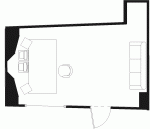PickMan, your room seems long enough (assuming your speakers/desk are on the SHORT wall) to be able to get the speakers far enough from the walls and still have at least 11 feet from your head to the rear wall - if not, anything reflective on the rear wall (behind you) isn't a good idea. Causes early reflections back to you, muddies the stereo imaging)
If you CAN get the necessary 11 feet or more, slots on the rear should be fine - they take care of the low mid/upper bass that makes most rooms muddy, and will slightly diffuse the highs.
I would probably alternate slots with a couple of home-built quadratic diffusors 10-12" deep, given you have the 11-12 foot (kor more) gap from your head to the back wall.
There is a simple spreadsheet I wrote about 12 years ago here
http://www.prorec.com/prorec/downloads.nsf/category
If you have Excel or Lotus, download the file "roomtune" - it is a self-extracting file with both versions of the spreadsheet and a basic docs file, it will tell you what the primary modal frequencies of your room are. Generally, you want at least 5 hZ between modes, and not more than 20 hZ.
There is a more complex one that includes Tangential (4 surfaces) and Oblique (all 6 surfaces) modes, as well as Bonello distribution charts (explained briefly in the spreadsheet itself) that I found last year (thankfully BEFORE I started to expand on mine) located here - the directions embedded in the first page of the spreadsheet explain the basics of how to use - I got tired of converting to inches, so I changed the feet cells (right of the inches cells) from a formula to an entered #, and saved it under a different name - now, I can use either.
http://www.studiotips.com/tools/MODESv2p.zip
Or, if that link doesn't work, go here and click on the file
http://www.studiotips.com/
when you get there, click calculation tools, and the first file on top is the one.
Be sure to follow the directions on the sheet - if you don't do a [ctrl][shift]S, [ctrl][shift]C after changing dimensions, it won't update info and you'll be looking at incorrect data.
Also, a quick way to find out if your room has problems with this sheet is to look at the Bonello chart page - you want taller blue than red in each band, otherwise it's a problem... Steve

